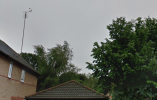PLEASE
Do make a full set of Signal/Quality measurement on both Aura and your -T2 before altering the aerial.
and Repeat them when canted over to Vp.
I'd really like to know the Field numbers from Wolfane for Rowridge Vp and Hp (though it should be -6dB on Vp as Wolfbane gives the number for the weakest 50kW muxes).
That'll allow gain loss calcs to see if the system provides the ideal 45-65 dBuV at the outlets.
The aerial amp has two +18dB outs... that's high level for sending signals down very long cables / to passive split outlets. On any multiple outlet Distribution Amplifier with a FULL (+18dB) outlet the makers supply a terminator. Read what Justin writes about this particular issue https://www.aerialsandtv.com/knowledge/splitters-amps-and-diplexers#amplifier-terminators
I must also say that you should remove that aerial combiner from circuit... or at least terminate (?short?) the other input to prevent anything stray/direct pickup from getting into the masthead amp at the higher frequencies.
Do make a full set of Signal/Quality measurement on both Aura and your -T2 before altering the aerial.
and Repeat them when canted over to Vp.
I'd really like to know the Field numbers from Wolfane for Rowridge Vp and Hp (though it should be -6dB on Vp as Wolfbane gives the number for the weakest 50kW muxes).
That'll allow gain loss calcs to see if the system provides the ideal 45-65 dBuV at the outlets.
The aerial amp has two +18dB outs... that's high level for sending signals down very long cables / to passive split outlets. On any multiple outlet Distribution Amplifier with a FULL (+18dB) outlet the makers supply a terminator. Read what Justin writes about this particular issue https://www.aerialsandtv.com/knowledge/splitters-amps-and-diplexers#amplifier-terminators
I must also say that you should remove that aerial combiner from circuit... or at least terminate (?short?) the other input to prevent anything stray/direct pickup from getting into the masthead amp at the higher frequencies.



 25 dB over the max ideal. {Or 19 dB for the -6 dB COMs in Hp}.
25 dB over the max ideal. {Or 19 dB for the -6 dB COMs in Hp}.



